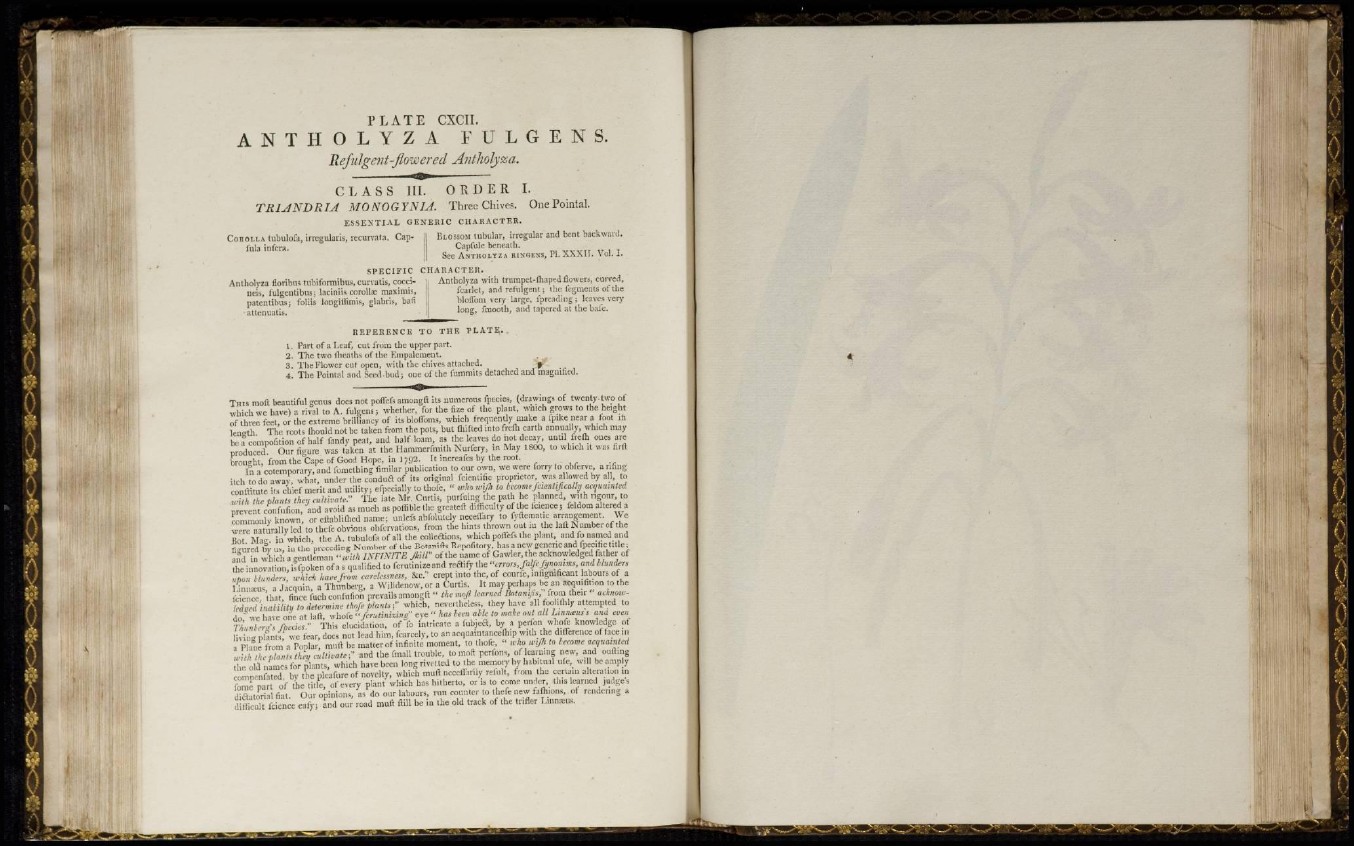
P L A T E CXCII.
A N T H O L Y Z A F U L G E N S.
Refulgent-flowered Antholyza.
C L A S S III. ORDER I.
T R I A N D R I A M O N O G Y N U . Three Chives. One Pointal.
E S S E N T I A L GENERIC CHARACTER.
C O R O L L A tubulofa, irregularis, rtcurvata. Cap- jj BLOSSOM tubular, irregular and bent backward,
fula infers. Capfule beneath.
!L See A N T H O L Y Z A RINOENS, PI. X X X I I . Vol. I .
S P E C I F I C CHARACTER.
Antholyza floribus tubiformibns, curvatis, cocci- ;, Antholyza with trumpet-iliapt-d flowers, curved,
neis, fulgentibus; laciniis corolla; maximis, |j fcarlet, and refulgent; ihc fegments of the
patenlibus; foliis longillimis, glabris, bati j; hloflbm very large, fpreading; leaves very
attcnuatis. long, fmooth, and tapered at the bale.
REFERENCE TO T H E P L A T E .
1. Part of a Leaf, cut from the upper part.
2. The two flienths of the Empalement.
3. The Flower cut open, with the chives attached. f
4. The Pointal and Seed-bud; one of the fummits detached and magnified.
T H I S molt beautiful genus does not poflefs amongfi its numerous fpecies, (drawings of tweuty-two o f
which w e have) a rival to A . fulgcns ; whether, for the iize of the plant, which grows to the height
of three feet, or the extreme brilliancy of its bloflbms, which frequently make a fpike near a foot in
length. The roots lhould not be taken from the pots, but fliifted into frefli earth annually, winch may
be a competition of half fandy peat, and half loam, as ihe leaves do not decay, until frefli ones are
produced. Our figure was taken at the Hammerfmilh Xurfery, in May 18O0, to which it was firft
brought, from the Cape of Good Hope, in J 7 9 2 . It increafes by the root.
In a cotemporary, and fomething fimilar publication to our own, we were forry to obferve, a riling
itch to do away, what, under the conduct of its original feieruiric proprietor, was allowed by all, to
conftitute its chief merit and utility; efpecially to thole, " who wißt to become fcientificaliy acquainted
irith ihe plants they cultivate." The late Mr. Curtis, purfuing the path he planned, with rigour, to
prevent confufion, and avoid as much as pollible the grcatett diiikulty of the fcience; feldom altered a
commonly known, or eltablilhcd name; unlefs abfolutely necelVary to fyflematic arrangement, We
were naturally led to thefe obvious oblervations, from the hints thrown out in the l aß Number of the
Bot. Mag. in which, the A . tubulofa of all the collections, which pollers the plant, and fo named and
figured by u s , in the preceding Number of the Botanills Repofitory, has a new generic and Ipecilic title;
and in -which a gentleman "with INFINITE jk'dl" of the name of Gawler, the acknowledged father of
the innovation, isfpoken of a s qualified to fcrutinizeand rectify the "<rn,rs,fa!fe fynonims, and blunders
upon blunders, which /tarefrom carelessness, Sec." crept into the, of coune, inligniticaut labours of a
l.innxuc, a Jacquin, a Thun berg, a Willdenow, or a Curtis. It may perhaps be an acquintion lo the
fcience, that, lince luch confufion prevails amongff " the miß learned Jiotanijis" from their " acknowledged
inability to determine thofe plants j" which, nevertheless, they have all fonlilhly attempted to
do, we have one at laft, whole "fcrutinizing" eye " has been able to make out all Linnaus's and even
T/utnberg's fpecies." This elucidation, of lb intricate a iubject, by I perfon whofe knowledge of
living plants, we fear, docs not lead him, lcarccly, to an acquaintaucelhip with the difference of face in
a Plane from a Poplar, muff be matierof infinite moment, 10 thole, " who wißt to become acquainted
with the plants they cultivate;" and the finall trouble, to mnft perfons, of learning new, and oufling
the old names for plants, which have been long rivelted to the memory hy habitual ule, will be amply
compenfated. by the pleafnreof novelty, which mull neceff'iriiy remit, from the certain alteration in
fume part of the title, of every plant which has hitherto, or is to come uirler, this learned judge's
dictatorial fiat. Our opinions, as do our labours, run counter to thefe new falhions, of renderin" a
difficult fcience e:ify; and our road mull Hill be in the old track o f the trifler Linmeus.